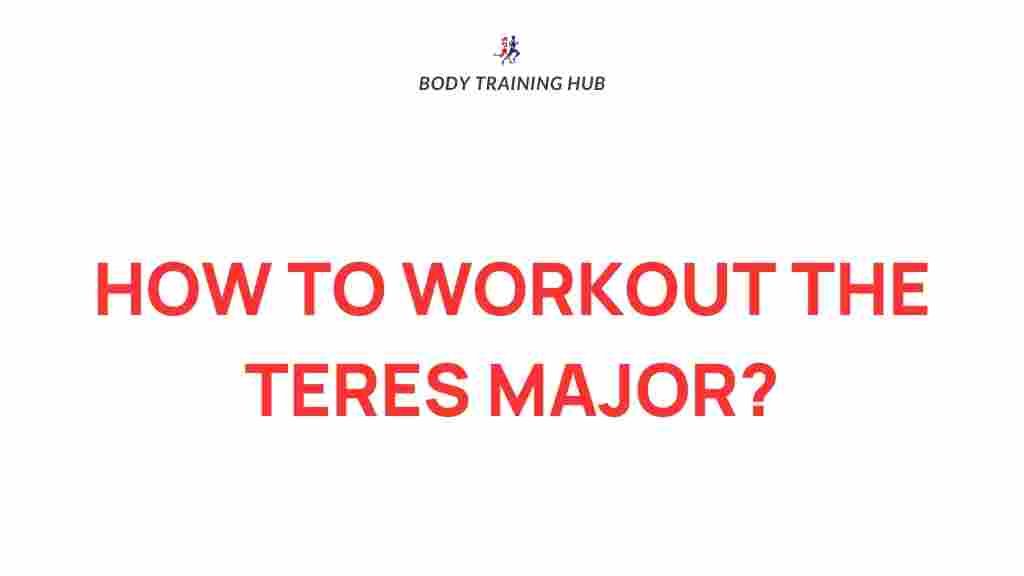Teres Major: Unlocking the Potential of This Underrated Muscle
The teres major muscle, often overshadowed by its more prominent counterparts in the upper body, plays a crucial role in shoulder movement and stability. Understanding how to properly activate and strengthen this muscle can significantly enhance your upper body workouts, improve your posture, and boost overall strength training results. In this article, we will delve into the teres major, explore effective shoulder exercises, and provide a comprehensive guide to muscle activation.
Understanding the Teres Major Muscle
Located in the back, the teres major muscle is a small, yet powerful muscle that connects the scapula to the humerus. It is primarily responsible for shoulder extension, adduction, and internal rotation. Although it’s not as well-known as other shoulder muscles, such as the deltoids or rotator cuff, its activation is vital for a well-rounded upper body workout.
The Importance of Muscle Activation
Muscle activation refers to the process of engaging specific muscles during exercise to maximize efficiency and effectiveness. For the teres major, proper activation can lead to:
- Improved shoulder stability
- Increased strength during upper body movements
- Enhanced athletic performance
- Reduced risk of injury
To ensure optimal muscle activation, it is crucial to incorporate targeted shoulder exercises into your strength training routine. Let’s explore some effective exercises that focus on the teres major.
Effective Shoulder Exercises for Teres Major Activation
Here are some exercises designed to activate and strengthen the teres major muscle:
1. Dumbbell Pullover
The dumbbell pullover is an excellent exercise for engaging the teres major along with the lats and chest.
- Lie on a flat bench with a dumbbell held above your chest, arms extended.
- Slowly lower the dumbbell back over your head while keeping a slight bend in your elbows.
- Engage your core and pull the dumbbell back to the starting position.
2. Bent-Over Dumbbell Row
This exercise not only targets the teres major but also works on the lower back and biceps.
- Stand with feet shoulder-width apart and hinge at your hips, keeping your back straight.
- Hold a dumbbell in each hand with palms facing each other.
- Pull the dumbbells towards your hips, squeezing your shoulder blades together.
- Lower the weights back down and repeat.
3. Cable Face Pull
Cable face pulls are great for activating the teres major and improving shoulder health.
- Attach a rope to the high pulley of a cable machine.
- Stand facing the machine and grasp the rope with both hands.
- Pull the rope towards your face, keeping your elbows high and squeezing your shoulder blades together.
- Return to the starting position and repeat.
4. Lat Pulldown with a Close Grip
This variation of the lat pulldown emphasizes the teres major while also working the lats.
- Sit at a lat pulldown machine and grasp the close grip attachment.
- Pull the bar down towards your chest while leaning back slightly.
- Focus on squeezing your back muscles as you pull the bar down.
- Slowly return to the starting position and repeat.
Step-by-Step Guide to Muscle Activation
Proper muscle activation is essential for maximizing the benefits of your upper body workouts. Here’s a step-by-step guide to ensure you effectively activate the teres major muscle:
- Warm-Up: Always start with a dynamic warm-up to increase blood flow to your muscles. Focus on shoulder circles and arm swings.
- Mind-Muscle Connection: Before starting your workout, take a moment to focus on your teres major. Visualize the muscle and imagine it contracting during your exercises.
- Use Light Weights: Begin with lighter weights to focus on form and muscle activation. As you become more comfortable, gradually increase the weight.
- Engage Core Muscles: Maintaining core stability will help isolate the teres major during exercises. Ensure your core is engaged throughout your workout.
- Cool Down: After your workout, take time to stretch and cool down. This can help with recovery and maintain flexibility in your shoulders.
Troubleshooting Tips for Effective Muscle Activation
If you’re struggling to activate your teres major during workouts, consider these troubleshooting tips:
- Check Your Form: Poor form can hinder muscle activation. Ensure you are using the correct technique for each exercise.
- Focus on Resistance: Use resistance bands or lighter weights to emphasize the muscle’s contraction during exercises.
- Mind Muscles: Concentrate on the teres major during each rep. Visualization can enhance activation and help with engagement.
- Modify Exercises: If an exercise feels too challenging, consider modifying it to better suit your current strength level.
Integrating Teres Major Activation into Your Routine
To reap the benefits of teres major activation, it’s essential to incorporate these exercises into your strength training regimen. Here’s how to do it:
- Frequency: Aim to include teres major-targeting exercises 2-3 times a week within your overall upper body workout routine.
- Variety: Mix different exercises to target the teres major from various angles, ensuring comprehensive strength development.
- Progression: Gradually increase weights and resistance over time to promote strength gains and prevent plateaus.
Conclusion
The teres major muscle plays a significant role in upper body strength and stability, making it a critical focus for anyone engaging in strength training or upper body workouts. By understanding how to effectively activate this muscle and incorporating targeted shoulder exercises into your routine, you can improve your overall performance, enhance shoulder health, and reduce the risk of injury. Remember, proper muscle activation is key to achieving your fitness goals.
For more information on effective strength training techniques, check out this guide. To explore a range of exercises focused on muscle activation, visit this resource.
This article is in the category Strength & Recovery and created by BodyTraining Team
